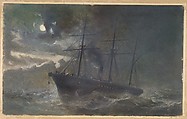The Albany Buoying a Bight of the Cable of 1865 on the Night of August 26th, 1866
Robert Charles Dudley British
Not on view
One of the 19th century's great technological achievements was to lay a telegraphic cable beneath the Atlantic, allowing messages to speed back and forth between North America and Europe in minutes, rather than ten or twelve days by steamer. An initially successful attempt in 1858, led by Cyrus W. Field and financed by the Atlantic Telegraph Company, failed after three weeks. Two working cables were finally laid in July and September 1866, the result of repeated efforts by the indefatigable Field, a cadre of engineers, technicians, and sailors, two groups of financial backers, and significant help from the British and United States navies. Dudley documented the process in a series of watercolors and oils, this example showing the Albany participating in the campaign to find the cable lost the prevous summer. Between August 8 and September 2, 1866 the cable fleet made repeated grapplling and hoisting forays. Here, a loop or bight further along the line has been brought to the surface, although the end would not be secured for another eight days. In 1892 Field donated art works by Dudley, commemorative medals, memorabilia, and specimens of cable to the Museum.
Due to rights restrictions, this image cannot be enlarged, viewed at full screen, or downloaded.


